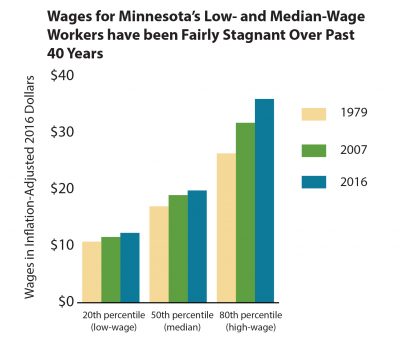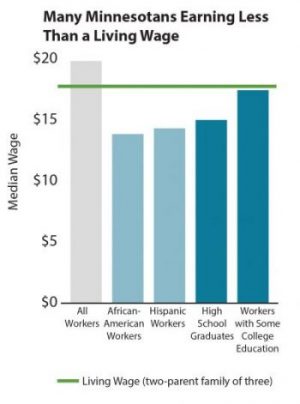Minnesota has experienced a fairly strong economic recovery since the Great Recession, with low overall unemployment and a growing economy. However, as of 2016 many Minnesotans have not seen the growth in wages that we would expect eight years into an economic recovery, according to data from the Economic Policy Institute.
As a result, many working Minnesotans can’t meet their basic needs for child care, transportation, housing and health care. The inflation-adjusted wages of many Minnesotans have only recently gotten back to where they were before the Great Recession hit, and wages aren’t keeping up with the cost of living.
Wage Growth Faster at the Top

Even though the recession ended in 2009, Minnesota low-wage workers’ wages have just recently caught up to pre-recession levels. Since the 1970s, we’ve seen a national trend of wage growth going primarily to high-wage workers, and very slow growing wages for other American workers. Since 1979, inflation-adjusted wages have only increased by about 15 percent for low- and median-wage workers while high-wage workers’ wages have increased by 36 percent. The new wealth being created in our economy clearly has gone primarily to the highest earners and has not found its way to many who have worked hard at the bottom and middle of the pay scale.
Many Workers Struggle to Make Ends Meet
Many Minnesota workers earn less than what it takes to support a family. The Minnesota Department of Employment and Economic Development calculates that both parents in a typical family of three would need to earn $17.69 per hour to afford their basic needs.
 This basic needs budget only includes necessary expenses that Minnesota families face, such as the cost of food, child care, housing, and health care. It does not include money for savings, entertainment, or vacations. However, there are just not enough living-wage jobs that pay enough to cover basic needs. And workers of color and workers with lower levels of formal education are more likely to lack living-wage jobs. In 2016, over half of Minnesota’s African-American and Hispanic workers and workers without a college degree made less than the living wage to support a family of three. And we also know that workers in Greater Minnesota face a larger gap between what they earn and what it costs to make ends meet. These workers are integral to our state’s economy, yet today too many don’t earn enough to support a family.
This basic needs budget only includes necessary expenses that Minnesota families face, such as the cost of food, child care, housing, and health care. It does not include money for savings, entertainment, or vacations. However, there are just not enough living-wage jobs that pay enough to cover basic needs. And workers of color and workers with lower levels of formal education are more likely to lack living-wage jobs. In 2016, over half of Minnesota’s African-American and Hispanic workers and workers without a college degree made less than the living wage to support a family of three. And we also know that workers in Greater Minnesota face a larger gap between what they earn and what it costs to make ends meet. These workers are integral to our state’s economy, yet today too many don’t earn enough to support a family.
State policy choices can play an important role in building a future where all Minnesota workers benefit from the economic growth they help create. Policymakers can ensure that Minnesotans’ hard work pays off and build a strong economic future for all of us by supporting:
- Policies that improve job quality standards, such as expanding access to earned safe and sick time;
- Tax policies that narrow, rather than amplify, income inequality; and
- Policies that ensure Minnesotans can get the education and training they need, and can live near and get to good jobs that make full use of their skills.
-Clark Goldenrod and Nathan Williams